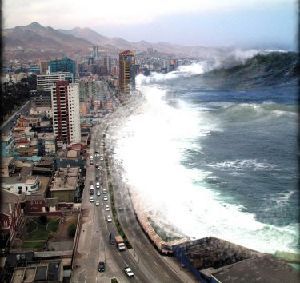日本3月11日发生特大地震引发海啸。电视画面显示,海啸迅速吞没了农田和房屋,汽车和船只被海啸席卷着撞上建筑物,造成了极大的人员伤亡和财产损失。让我们在哀悼灾难的同时,也来看一些海啸的求生技巧吧!
The Japanese coined the word tsunami to mean "harbor wave." ("tsu" means harbor, and the character "nami" means wave). In the wake of the Japanese tragedy, remember these tsunami survival tips:
1. A good warning sign of an approaching tsunami is "drawback," when the ocean recedes drastically or the water level falls unusually along the shoreline.
退潮是海啸的一个预警信号

During the 2004 Indian Ocean tsunami, a 10-year-old girl on vacation with her family in Thailand, Tilly Smith, saved the lives of dozens of tourists when she recognized the receding water and frothing bubbles on the surface of the water as a sign that a tsunami was on it's way. Experts believe that a receding ocean may give people as much as five minutes' warning to evacuate the area.
2. You're not out of danger after the first wave of a tsunami.
第一波海啸结束并不意味着脱险
A tsunami occurs as a series of waves known as a "wave train," and the series of surges can be five minutes or up to an hour apart. The tsunami does not usually appear on the shoreline as a gigantic breaking wave, but rather as a rapid tide or a wall of water. The worst mistake you can make is staying near the beach out of curiosity. Find higher ground and go as far inland as you can. If you can see the waves, you're still too close.
3. A tsunami surge may be small at one point of the shore and large at another point.
趁海啸势头小的时候向高处转移
Move to higher ground as soon as you can and don't assume that because there's minimal activity in the coastal area where you are, it will be like that everywhere else.
4. Keep your ears peeled.
捂紧耳朵
Many witnesses have said that a tsunami sounds thunderous, like a freight train.